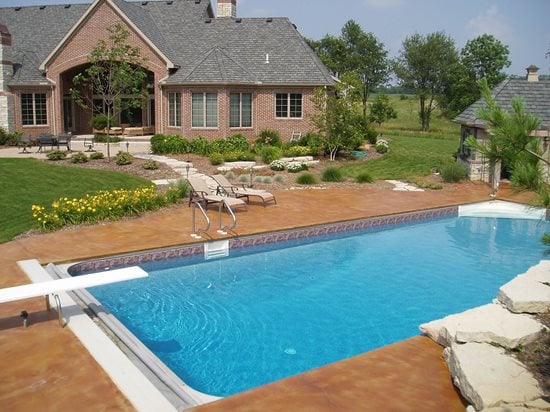
Concreations, LLC in Millersburg, IN
Pool deck repair brings new life to your concrete. If your surface has damage like cracking, spalling, or discoloration, but is still structurally audio, it could be a candidate for repairs. Options range from a simple color enhancement to total resurfacing.
Observe pool deck contractors near me
WHAT ARE SOME Mutual POOL DECK Bug?
| Problem | Repair Options |
| Cracks | Filler
Patch
Joint sealant |
| Spalling | Patch
Overlay |
| Discoloration or stains | Pressure washer
Cleaners
Coloring agents |
| Sealer failure | Strip and reseal |
| Slippery concrete | Grit additive |
| Settlement | Slabjacking (lifting) |
How does each repair option work?
- Filler — fills small cracks to add together strength to a weakened expanse of the surface
- Joint sealant — prevents moisture from getting into joints or cracks and causing further impairment
- Patch — used to prepare larger cracks, or shine areas of spalling
- Overlay — creates a fresh new surface for the unabridged pool deck
- Pressure level washer or cleaners — used to clean the surface of diverse stains
- Coloring agents — surface practical colors such equally stains can aid camouflage imperfections
- Strip and reseal — chemicals are used to remove the failing sealer and a new one is applied
- Grit additives — added to the sealer to meliorate slip resistance
- Slabjacking foam — injected beneath settled concrete to enhance it back into level
Tip: Some coating manufacturers sell patch kits, and then check with them first. Be sure to ask about color matching.
Detect concrete repair products
WHY IS MY POOL DECK CRACKING?
Minor cracking is very normal for a concrete pool deck. Hairline cracks are only a problem if they detract from the appearance of the surface. If you lot are concerned that the cracks effectually your pond puddle are more serious, have a concrete contractor out to assess the damage.
Here are a few reasons that your concrete surface may have cracks:
- Freeze-thaw impairment — Concrete is porous, which may allow water to go far. When that water freezes small flakes from the surface can break off.
- Deicing salts — Salts applied in the winter can release alkaline chemicals that can make the freeze-thaw impairment worsen.
- Not enough control joints — Without properly placed expansion joints, your concrete won't be able to expand and contract with the weather.
- Lack of reinforcement — Without whatever steel in the construction, cracks tin occur, every bit the rebar holds the concrete together.
- Weak concrete — If there was too much water in the mix when it was poured, the concrete may be weak, and susceptible to cracks and surface problems.
HOW TO Ready CRACKS IN YOUR CONCRETE Puddle DECK
If you demand to set a fissure in your physical, you lot can either patch or fill it.
In club to fill a crack, follow these steps:
- Chisel out the crack to remove loose pieces of concrete
- Clean the debris, including all dust and fries with a broom, shop vac or air compressor
- Apply filler directly into cracks, checking periodically to meet if information technology has settled
- Allow the filler to cure over a 24-60 minutes period
- Seal the filled area for long-lasting results
HOW DO You lot PATCH A POOL DECK?
Patching is primarily used for fixing spalling or larger cracks. Spalling is when your physical surface starts to chip and flake. When this happens, you accept two options: resurface the entire pool deck or patch the problematic spots.
Patching makes the most sense when there are only a few pocket-sized areas of spalling. If a majority of the surface is affected, resurfacing is the best solution.
The patching process is very similar to filling. Commencement, fix and clean the damaged area. Then apply the patching material and permit it to cure. Finally, seal your repairs or have an overlay practical to the entire deck.
HOW DO Yous FIX SINKING Physical AROUND YOUR POOL?
If your physical surface is sinking, a contractor tin employ a technique called slabjacking to set up the problem. This option can prevent you having to remove your puddle deck altogether.
The slabjacking process follows these steps:
- A pattern of holes are drilled through the sunken slab.
- A grout mixture is pumped under the slab, lifting it to the desired peak.
- The holes are patched using a physical mixture.
SHOULD I Effort TO FIX MY POOL DECK MYSELF?
Some physical repairs can be washed as a DIY, only it is highly recommended to hire a contractor for more complicated tasks. There are many patching and filling products bachelor that make fixing pocket-sized cracks easy for a homeowner to exercise themselves.
However, if the task requires you to practice a full resurface, or employ materials that need to exist leveled, a professional contractor will be the best choice for your project. A contractor is more likely to complete the job on time, without error, and with a finished look you'll enjoy for years to come.
WHAT TO Do Later YOU'VE Made REPAIRS
If y'all've patched or filled cracks in your physical puddle deck, and are unhappy with the results, you lot tin resurface information technology with a concrete coating. This overlay offers an opportunity to update the decorative appearance of the physical, as well as cover upward any repair work.
Pool deck resurfacing
If your pool deck has extensive cracking, scaling or spalling, the best solution is to resurface it with a concrete overlay or microtopping. Resurfacing covers upward existing flaws and upgrades the look of your pool by assuasive you lot to add together color, texture, and design. Some systems are designed specifically for resurfacing pool decks, and will meliorate the slip resistance of the surface and too reflect oestrus. (Come across What Blazon of Puddle Deck Overlay Will Stay Cool?)
Here are the steps to expect when your contractor is resurfacing your puddle deck:
- Prepping — The old surface is ground or treated with chemicals to aid the overlay bond.
- Cleaning — Whatsoever dust or debris is removed with a broom and hose or force per unit area washer.
- Mixing — The overlay product is mixed, along with any integral colors, or tints.
- Applying — The cloth is sprayed or troweled on, and decorative treatments are added.
- Sealing — In one case cured, a sealer is applied to protect your puddle deck for years.
Tip: Some coatings are formulated to dry quickly, making it possible to give a pool deck a decorative makeover in as little equally a twenty-four hours.
MORE REPAIR IDEAS FOR CONCRETE Pool DECKS
Concrete engraving
For physical with minor cracking or discoloration, you can completely disguise the flaws by engraving or cutting a design in the surface. Depending on the blueprint you choose, the flaws in the physical tin can actually contribute to the look. With engraving, the concrete is stained outset and and so a special routing motorcar is used to cutting the blueprint into the surface, creating faux grout lines. See examples of concrete engraving.
Recoloring
Although most concrete stains, colour hardeners, integral pigments and other coloring methods are long-lasting and vesture-resistant, years of neglect can take a price. Discoloration of concrete pool decks can be due to a number of causes including weathering, sunday exposure, improper colour awarding, and attack by pool chemicals. The proficient news is that in most cases the concrete colour can be revived by applying a new coat of acid or water-based stain. By using a UV-resistant staining product and by protecting the concrete with a practiced sealer, your newly colored pool deck should maintain its dazzler for many years. For more data on choosing and applying physical stains, read these Stained Concrete FAQs.
Run into these physical puddle deck repair projects:
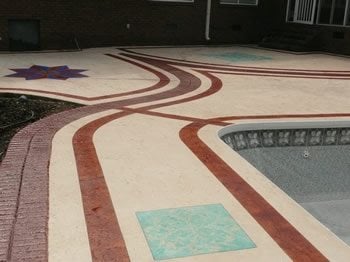
Correcting Someone Else'due south Mistakes
A microtopping enhanced by decorative brick-patterned borders and stenciled designs gave this dysfunctional pool deck new life. Before the topping could be applied, large cracks in the deck were repaired by stitching and filling them with mortar, and and so a swale was installed to aid correct a drainage problem.
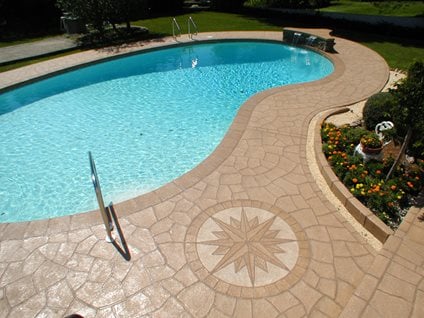
Resurfaced Concrete Pool Deck Makes a Big Splash
A cast-in-place concrete overlay, stamped with a fieldstone pattern and a decorative medallion, completely restored this deteriorating physical pool deck without the demand for replacement. Because the existing concrete deck had extensive cracking and settlement, the overlay was poured at a 1 ½-inch thickness and reinforced to prevent failure.
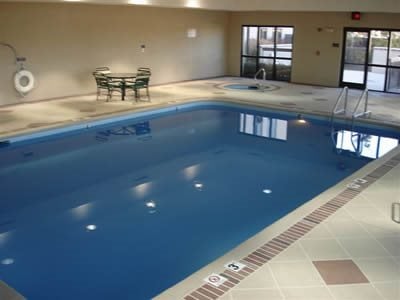
Hotel Pool Deck Resurfacing
In improver to chemical and difficult water stains, this indoor hotel pool deck had a rough surface that was unfriendly to bare anxiety. The solution was to resurface it with a durable and attractive acrylic topping and add a brick-patterned border to define the edge of the puddle and better the visibility.
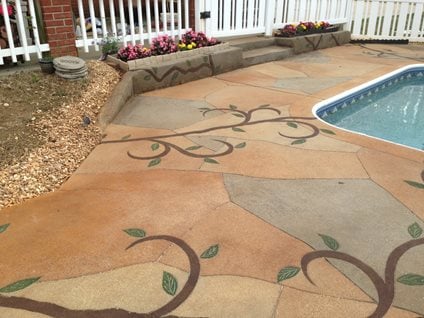
"De-Vine" Pool Deck Revamp
For this puddle deck makeover, vine designs colored with water-based acrylic stains were used to plow cracks into unique focal points. The surface was also given a random flagstone pattern created past sawcutting and staining.
POOL DECK REPAIR Q&AS
Decorative concrete practiced Chris Sullivan addresses mutual problems relating to pool decks.
Spots on stamped pool deck may be sealer improvidence
Question: Nosotros have an effect with efflorescence on a stamped concrete pool deck and need your advice. The concluding time the puddle deck was sealed was most three years ago. Well-nigh a month ago, nosotros resealed the deck and at present it has white spots (see photo). Nosotros used a 30%-solids solvent-based acrylic sealer. We applied the sealer to a test expanse about 3 months before nosotros resealed, and there did non seem to exist any issues. Before resealing, we cleaned the deck with a mild acid wash, neutralized, and so allowed the sealer to dry. We then practical 1 coat of sealer diluted with xylene followed by a 2nd glaze rolled on full force.
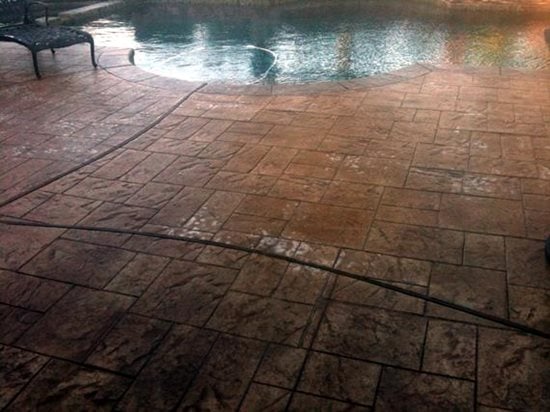
The grayish-white spots on this pool deck may indicate sealer diffusion, a condition in which the sealer lifts from the physical.
What is causing the white spots, and what percent of acrylic sealer or type of sealer do you recommend for a stamped pool deck?
Answer: From the picture, it appears that efflorescence may not be the problem. These white spots are actually more gray, and they don't have the look of efflorescence. Instead, this looks like sealer diffusion. This miracle, where the sealer is no longer adhered to the concrete, looks a lot similar efflorescence from a distance, merely on closer inspection is really more gray or cloudy. Without getting into circuitous physics, the sealer has lifted (even if only past micro-meters) and it causes the discoloration. The pocket-size air gap that now exists between the sealer and concrete causes the light to lengthened and create the grayish-white cloudy wait. Moisture-vapor pressure, contamination or over-application of the sealer tin crusade this problem. To confirm this diagnosis, practise a sealer-adhesion scratch test or but lightly scratch the sealer with a key or some other difficult blunt-end object. If the sealer holds and does not scrap, information technology may be something else. If it flakes, splinters, or comes off easily (which I retrieve it will), it is probably improvidence.
Another thing it may be is moisture condensation trapped nether the sealer. Take you had whatsoever major moisture weather events in the weeks prior to this occurring? As with nearly decorative physical issues, it could exist a combination of both of these things, with a little efflorescence thrown in for proficient measure.
To fix the problem, I would wait until the winter is over and y'all get some warmer weather condition. A xylene bathroom (lightly soaking the trouble area with a xylene solvent and back rolling) is the get-go step. If this does not work, yous will probably need to strip off some or all of the sealer.
For whatever exterior stamped concrete that will be sealed, and especially pool decks, I accept a few hard, fast recommendations:
-
Use light colors for the slab. Dark colors show everything, especially all the chemical rest from pool water, including chlorine, bromine and salt.
-
Use less-aggressive stamp patterns. Water seeks low spots. If you have lots of "grout" lines and or lots of rough texture, water volition puddle in those depression areas. Pool decks are wet to beginning, so the combination tin can exist specially bad. Lighter-texture seamless patterns with simple sawcuts or large light-texture rock patterns work all-time.
-
Utilise a sealer with a solids content of less than twenty%. Less is more, and this is especially true when sealing decks effectually pools and hot tubs. Lower solids allow wet and air to motion through the sealer easier. Lower solids also reduce the take a chance of slipping accidents. Consider using a solvent-based acrylic sealer with an eighteen% to 20% solids content. They provide dainty gloss, good color development, and greatly reduce callbacks.
Excess antiquing colour causes problems
Question: I have a pool deck in which the sealer seems to be flaking off and coming up in some areas. This is not an event that we accept dealt with before, so I am a little concerned. Tin you allow united states know what is occurring and how we can remedy this issue?
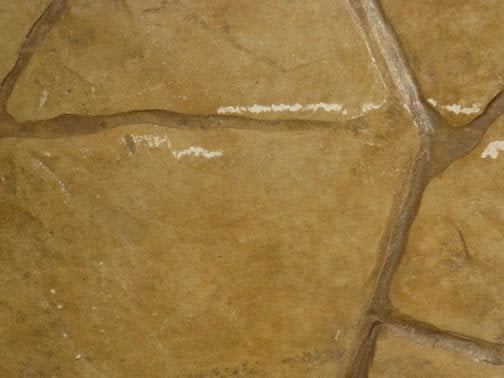
A good rule to work by is that secondary color should make up 5% to 30% of the final color. In this case, the secondary color makes up near 100% of the surface color, causing sealer failure.
Respond: This is actually ane of the most common issues we face with coloring stamped physical. It is in fact non a sealer outcome, but rather the antiquing colour that is causing the sealer to fail. The sealer failure can occur inside weeks of application, but more than often shows up 6 to 12 months down the road.
Imprinted concrete looks pretty bland and unrealistic without highlights or antiquing, which give the design definition and color variation. These highlights make the concrete look like stone, tile or whatever natural material the installer is trying to mimic. The highlights tin can exist accomplished in a multitude of ways, with release powder beingness the about common. Other popular methods include stains, tints, dyes and colored sealers. Virtually whatever means of getting some contrasting color to stick in the depressions and textured areas of the surface will work. The problem occurs when too much secondary color is present. The depth and type of texture on the imprinting tool volition determine the amount of secondary color to use. More than aggressive textures with deep grout lines, lots of deep veins, and crude slate or stone surfaces will accommodate more secondary or antiquing color. The reverse holds true for light textures with smoother surfaces and non-ambitious patterns. A skilful dominion to work past is that secondary color should make upward five% to thirty% of the final colour. In your example, however, the secondary colour makes up almost 100% of the surface color.
The real bend brawl is that stamped work with such high ratios of secondary color can look astonishing and beautiful. Once sealed, the piece of work looks great, the applicator gets paid and everyone is happy. The problem is that y'all have ticking fourth dimension bomb, and it is just a matter of time before it explodes. Have you ever considered what secondary color is made of and how it works? No matter whether you apply release powder, stains, washes or tints, you are filling the surface pores of the physical with solid textile. Those solids are filling the voids that the sealer needs to fill in gild to "seize with teeth" or adhere to the physical. The more secondary color present, the bigger the problem. The sealer will encapsulate the solid color in an attempt to do its job, but if in that location are no pores to fill, adhesion is compromised, which leads to failure when external forces exceed the ability for the sealer to concord. This is usually why nosotros see these types of failures in the bound, after a winter assault of freeze-thaw cycles, deicing salts and snowfall shovels. As a result, the sealer lifts up in small circular areas and takes the secondary color with it, since the colour is all information technology had to hold onto. You are then left with a stamped slab that has circular, discolored spots. The "discoloration" is really the base of operations color that should have been visible in the first place, only was covered with too much secondary color.
The repair is fairly simple in theory, merely more hard in practice. The sealer has to be chemically stripped, but the procedure will usually remove virtually of the secondary color likewise. Once the stripping is complete, you tin remove whatsoever residual secondary color, give the surface a good cleaning, and so allow it to dry before resealing. The hard part is selling the client on the new "right" color combination of their patio. What was mostly dark brown with hints of tan is now mostly tan with hints of dark brownish.
Bad concrete causes decorative disaster
Question: I hope y'all can give me some idea about what's going on with my concrete pool deck. The deck was poured in Baronial 2005 by a local contractor, who then stamped the physical in an Ashlar slate blueprint using a dry color release. After he done off the residual dry color from the surface, the deck did non look evenly colored. Some areas had barely any colour while others had too much. I told the contractor that the color was unacceptable and needed to be fixed before the sealing. Despite that, when I wasn't home the contractor went ahead and practical a sealer pigmented with a nighttime brown stain. That made the deck look fifty-fifty worse, but it isn't my biggest problem. After the first wintertime, which was balmy for the central Midwest, the decorative surface of the deck started to peel and chip away. In some big areas, the surface came off completely, down to the aggregate. I did not utilise deicing salts, and no h2o was left lying on the surface.
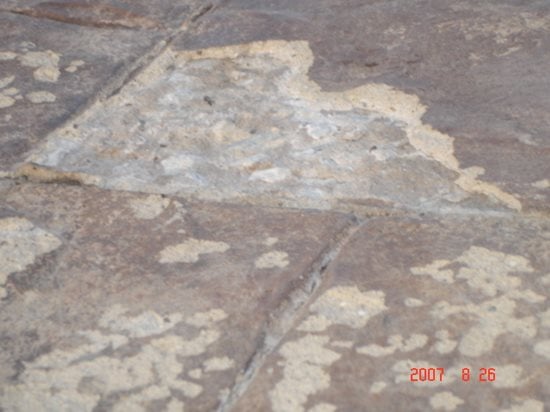
This stamped concrete patio is flaking abroad due to a surface layer of weak concrete.
Respond: Unfortunately, you take a slab of decorative concrete that'south in bad shape and beyond easy repair. As the photo clearly illustrates, the elevation 1/2 to 1 inch of the concrete surface is beginning to come off considering the rock, which gives concrete its forcefulness, is pushed downward, leaving a weak sandy layer on elevation. One time the top surface has been breached, it's just a matter of time before the entire top will interruption autonomously. Considering the layer below with the stone showing appears to be strong and intact, you lot have two repair options: totally rip out and replace the slab or remove the top 1 inch and cover the underlying physical with a stamped overlay.
In my opinion, the trouble is not acquired past the contractor's coloring methods. Instead, information technology's probably due to poor installation techniques, poor curing, a bad physical mix or a combination of all three. Stamping the surface of bad concrete only speeds upward the deterioration process. What makes things worse is that the contractor is refusing to take whatsoever responsibility and will not get involved to assistance figure out what happened.
Agreement SPALLED Physical
Length: 06:08
Scout this easy-to-understand explanation of what causes physical spalling, from concrete good Chris Sullivan.
REPAIR SPALLED Concrete
Length: 05:17
Watch this easy-to-empathise caption on repairing spalled physical, from concrete expert Chris Sullivan.
RELATED:
Puddle Deck Cleaning









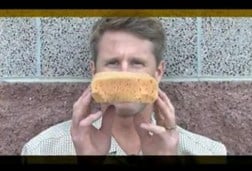
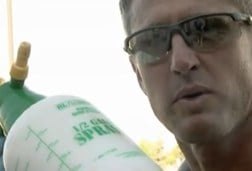

0 Response to "How Much Repair Pool Tx"
Post a Comment